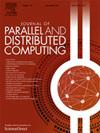GPU tabu search: A study on using GPU to solve massive instances of the maximum diversity problem
IF 3.4
3区 计算机科学
Q1 COMPUTER SCIENCE, THEORY & METHODS
引用次数: 0
Abstract
The maximum diversity problem (MDP), a widely studied combinatorial optimization problem due to its broad applications, has seen numerous heuristic methods proposed. However, none of these approaches have addressed the challenges posed by massive instances. Currently, state-of-the-art heuristics are not well-suited for massive instances due to two primary reasons. Firstly, they rely on a matrix-based representation, which proves highly inefficient for sparse instances commonly encountered in massive scenarios. Secondly, as the problem size increases, their local search operators experience a slowdown. This work introduces a GPU-based tabu search algorithm designed to tackle such massive instances. To address the limitations of the state-of-the-art heuristics, our GPU tabu search employs more efficient data structures for sparse instances and leverages GPU parallel capabilities to expedite the local search process. We tested our approach on established small and medium instances, ranging from 2,000 to 5,000 vertices, as well as massive instances with up to 45,000 vertices. In these tests, our approach was compared with a state-of-the-art algorithm. Experimental results demonstrate an up to 30x speedup with of our proposal and its effectiveness on massive instances.
GPU禁忌搜索:利用GPU解决大量实例最大多样性问题的研究
最大多样性问题(MDP)是一个被广泛研究的组合优化问题,由于其广泛的应用,已经提出了许多启发式方法。然而,这些方法都没有解决大规模实例带来的挑战。目前,由于两个主要原因,最先进的启发式方法不太适合大规模实例。首先,它们依赖于基于矩阵的表示,这对于在大规模场景中经常遇到的稀疏实例来说效率非常低。其次,随着问题规模的增加,它们的本地搜索操作会变慢。本文介绍了一种基于gpu的禁忌搜索算法,旨在处理此类大规模实例。为了解决最先进的启发式算法的局限性,我们的GPU禁忌搜索为稀疏实例采用了更有效的数据结构,并利用GPU并行功能来加快本地搜索过程。我们在已建立的小型和中型实例(从2000到5000个顶点)以及具有多达45,000个顶点的大型实例上测试了我们的方法。在这些测试中,我们的方法与最先进的算法进行了比较。实验结果表明,本文提出的算法可以提高30倍的速度,并且在海量实例上是有效的。
本文章由计算机程序翻译,如有差异,请以英文原文为准。
求助全文
约1分钟内获得全文
求助全文
来源期刊

Journal of Parallel and Distributed Computing
工程技术-计算机:理论方法
CiteScore
10.30
自引率
2.60%
发文量
172
审稿时长
12 months
期刊介绍:
This international journal is directed to researchers, engineers, educators, managers, programmers, and users of computers who have particular interests in parallel processing and/or distributed computing.
The Journal of Parallel and Distributed Computing publishes original research papers and timely review articles on the theory, design, evaluation, and use of parallel and/or distributed computing systems. The journal also features special issues on these topics; again covering the full range from the design to the use of our targeted systems.
 求助内容:
求助内容: 应助结果提醒方式:
应助结果提醒方式:


